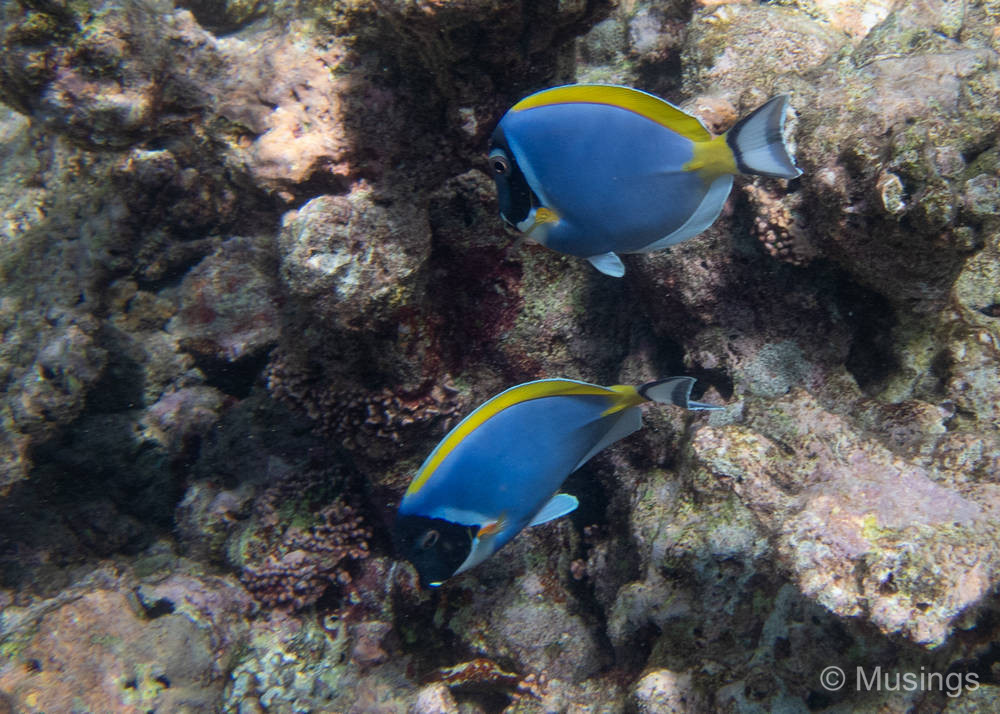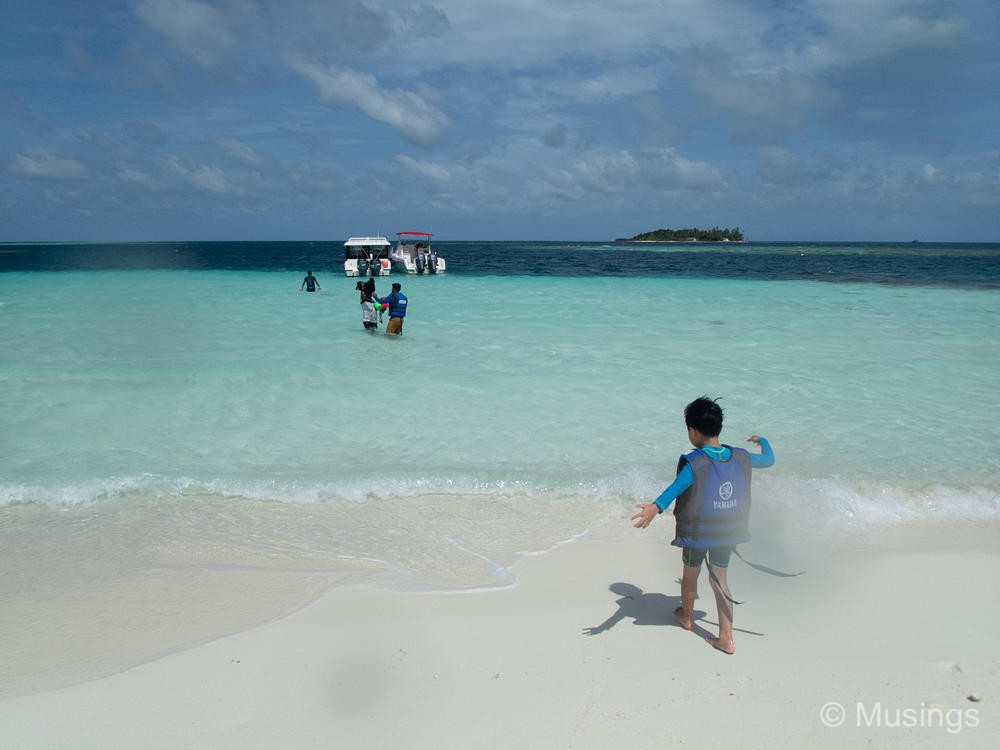Equipment wise, the Maldives trip turned out to be quite a varied experience: I bought just two lenses for the Sony A73 – the FE 24-105mm and Tamron 70-200mm f2.8 – and not unexpectedly, used the former far more than than I did the latter. But there was a large number of smaller-sized items that accompanied my Sony A73: and these included the ever trustworthy Canon G7X II, the new GoPro Hero 7 Black, Olympus TG-5, and the InstaOne 360 One X. The latter three equipment were for specific use-cases: 4K 60fps underwater footage on the GoPro 7, still shots with the TG-5, and 360 videos with the InstaOne.
Numbers-wise, I simply didn’t take as many photos as I could have, and only on account that I was knocked out of commission for most of the second half of the trip. So:
Sony A73: 1,096 photos in .ARW RAW format
Samsung Note 9: 300 photos in a mix of .JPG and .DNG RAW format + 39 videos in 4K 60fps video using the H.265 codec
Canon G7X II: 239 photos in .CR2 RAW format
Olympus TG-5: 685 photos in .ORF RAW format + 10 videos in 4K 60 fps
GoPro 7 Hero 7 Black: 75 videos in 4K 60 fps
Insta360 One X: 13 360 videos
Of the 2,320 photos I took this trip, I’m keeping 1,518 of them and most of the videos – making up about 82.4GB of data: 29.5GB of images and 31.3GB of 4K video, alongside another 21.6GB of 360 videos. That’s a keeper rate of 65.4%, better than the 56.5% and 57% I hit during the Taiwan and Western Australia trips respectively. Though that’s also because of a more deliberate shooting discipline this trip, and that I was off drive-mode for most of the trip too haha.
Further-on comments for each toy that came along for the trip:
The Sony A73 was on its third major trip out of the country – the previous two being Bali and Taiwan in Jun and Dec respectively last year – and continued to shine. Quick, responsive, reliable, and producing versatile RAW files that I could squeeze that bit more dynamic range from each time. I opted not to bring along a backup battery this trip too, reasoning that the 800+ shot longevity per charge is easily more than sufficient for each day, and I could use a powerbank on days where I expected to take more than that or chimp my photos. As it turned out, I didn’t take more than a few hundred shots each day this trip on the A73, so battery life turned out to be a real non-issue.
Of the two lenses – the FE 24-105mm f4.0 and Tamron 70-200mm f2.8 + Sigma MC-11 – the former, not surprisingly, saw really heavy use as a versatile all-rounder lens, while the Tamron came out to play only on Day 03’s visit to the local private beach @ Huraa Island and also Day 04’s trip to the sand bank. No complaints on either, but the next trip(s) to Japan later this year I’m almost for certain gonna bring along the FE 16-35mm f4.0 as well.
The GoPro 7 Hero Black is the manufacturer’s top-line mode, and I equipped it also with a cheapo underwater case just so I could mount a light red filter on top of the lens to remove some of the tint that would be present otherwise in the underwater footage. The footage could had been corrected in Adobe Premiere either way, but the filter at least removed a significant step that would had been necessary in post-processing. Oddly, the GoPro occasionally froze while operating underwater, and it seems a problem also faced by other users of the model. It could be fixed by forcing a hard-restart of the unit, but it sure was annoying – especially when we were underwater already.
Still, worth it!
The Olympus TG-5 was the other camera that accompanied us on all our snorkeling trips. I’ve got somewhat more mixed feelings of the TG-5. On the plus side, it’s a rugged camera and compact for its feature set. I could secure both the TG-5 with its flotation strap and the GoPro 7 with a handle grip off my life vest, which made it possible to drop both devices in an instant to keep my hands free when I needed to. The key characteristic of the TG-5 that made it possible also to produce these nifty underwater shots is that the TG-5 takes pictures in RAW format, which made possible all that substantial post-processing work, especially in adjusting color temperature (see the next post on this).
On the other hand, like the GoPro, it sure was difficult trying to frame shots properly on the TG-5! The very wide-angle lens on the GoPro 7 and its close focusing distance offered that bit more latitude, so I only needed to point the GoPro in the general direction of the subject, and get in as close as I could, confident that the resulting footage should be reasonably usable. The normal minimum focusing distance on the TG-5 is also a pretty close 10cm, but likely because I always instinctively attempt to frame a shot when using a stills camera that a good number of photographic opportunities got lost by the time I had the camera at half-arm’s length to compose a shot. Next time, I’ll just set the TG-5 to drive mode, and use it the same way as I did for the GoPro: just point the damn thing in the general direction of the critter and fire away on drive mode LOL.

Funnily, the experience of using the TG-5 above water however was even more problematic. Specifically, the front glass element of the TG-5’s lens is supposed to feature some kind of coating to discourage water droplets from sticking on the glass protective element when it comes out of water. In practice, the coating didn’t seem particularly effective. Water residue became a persistent issue. The couple of times I remembered to check the front glass element for water droplets, I couldn’t easily shake off the water droplet either. As a result, a good number of shots taken above water especially during our Day 04 trip to the sand bank were ruined.

Of the bunch of toys I brought along this trip, the one that saw the least use was the Insta360 One X. The 360 camera takes both great video footage and stills, but I think I was suffering from equipment fatigue from bringing this many toys over! I don’t think I’d thought through either how to best use the One X as it was a new acquisition just before we left. Quite a pity since the perspectives offered from a 360 camera are unique, and experienced owners of the camera have been able to get amazing results from it, judging from their YouTube footage. Stitching video in the InstaOne software was also straight-forward: you basically pull the two source segment files, accept the default parameters (they worked fine for me), and then let the software do its work. Except that the HP x2 G2 Pro 612’s low-voltage processor really struggled to process those big files! And we’re talking about 2-3 hours just to export a single 360 video file of 3 minutes length.
In any case, here are two video footage samples I took on the One X. The first is of us leaving for our first snorkeling trip on Day 02, and the second during our visit to the sand bank on Day 04. The firmware on the One X also did some incredible mojo making invisible the camera stick I was holding!
So, my takeaways. I doubt we’ll be doing another island resort vacation trip anytime soon. But if we do and it’s of similar scope and itinerary as this Maldives trip, then:
Sony A73 + FE 24-105mm f4.0 will cover 80% of my photographic needs.
The Tamron 70-200mm f2.8 + Sigma MC-11 is still a lethal combo when shooting from somewhat stand-off distance, or discretely.
The Canon G7X II is a nice back-up camera that I can use discretely without bringing out an intimidating full-frame camera.
The GoPro 7 with light-red filter in an underwater case will produce amazing underwater video footage. Just get ready to force re-start the camera when it freezes!
Set the Olympus TG-5 on drive mode, don’t worry about framing, and just fire away.
Read up more about the Insta360 One X and how to use it better before a trip!
The next post in my technical comments of our trip will focus on some Lightroom post-processing samples.
Recent comments